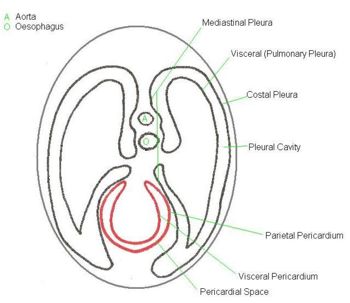Difference between revisions of "Pleural Cavity and Membranes - Anatomy & Physiology"
Jump to navigation
Jump to search
| Line 13: | Line 13: | ||
The surface of the inner wall of all of the body cavities are lined by a serous membrane which consists of a single layer of flat epithelium with a thin underlying propria (connective tissue). Within the thoracic cavity, this is known as the ''Pleura''. | The surface of the inner wall of all of the body cavities are lined by a serous membrane which consists of a single layer of flat epithelium with a thin underlying propria (connective tissue). Within the thoracic cavity, this is known as the ''Pleura''. | ||
| − | ==Structure== | + | ==Structure of the Pleural Membranes== |
| + | [[Image:PleuralMembranesSchematic.jpg|right|thumb|350px|'''Schematic Diagram of the Pleural Membranes''']] | ||
*Each lung is placed within a separatte layer of membrane, thus there are two pleural sacs. | *Each lung is placed within a separatte layer of membrane, thus there are two pleural sacs. | ||
*The space between the two sacs is known as the [[Mediastinum - Anatomy & Physiology|Mediastinum]]. | *The space between the two sacs is known as the [[Mediastinum - Anatomy & Physiology|Mediastinum]]. | ||
** | ** | ||
| + | |||
==Function== | ==Function== | ||
Revision as of 08:30, 13 August 2008
|
|
Introduction
The surface of the inner wall of all of the body cavities are lined by a serous membrane which consists of a single layer of flat epithelium with a thin underlying propria (connective tissue). Within the thoracic cavity, this is known as the Pleura.
Structure of the Pleural Membranes
- Each lung is placed within a separatte layer of membrane, thus there are two pleural sacs.
- The space between the two sacs is known as the Mediastinum.
